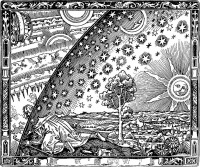Cosmography
From The Art and Popular Culture Encyclopedia

|
Related e |
|
Featured: |
Cosmography is the science that maps the general features of the universe, describing both heaven and Earth (but without encroaching on geography or astronomy). The 14th century work'Aja'ib al-makhluqat wa-ghara'ib al-mawjudat by Persian physician Zakariya al-Qazwini is considered to be an early work of cosmography.
Traditional Hindu, Buddhist and Jain cosmography schematize a universe centered on Mount Meru surrounded by rivers, continents and seas. These cosmographies posit a universe being repeatedly created and destroyed over time cycles of immense lengths, perhaps similar to some aspects of the Big Bang theory.
In 1551, Martín Cortés de Albacar, from Zaragoza, Spain, published Breve compendio de la esfera y del arte de navegar. Translated into English and reprinted several times,the work was of great influence in Britain for many years. He proposed spherical charts and mentioned magnetic deviation and the existence of magnetic poles.
Peter Heylyn's 1652 book "Cosmographie" (enlarged from his "Microcosmos" of 1621) was one of the earliest attempts to describe the entire world in English,and being the first known description of Australia and among the first of California. The book has 4 sections, examining the geography, politics, and cultures of Europe, Asia, Africa, and America, with an addendum on Terra Incognita, including Australia, and extending to Utopia, Fairyland, and the "Land of Chivalrie".
In 1659, Thomas Porter published a smaller, but extensive "Compendious Description of the Whole World", which also included a Chronology of world events from Creation forward. These were all part of a major trend in the European Renaissance to explore (and perhaps comprehend) the known world.
The word was also commonly used by Buckminster Fuller in his lectures.
In astrophysics, the term "cosmography" is beginning to be used to describe attempts to determine the large-scale geometry and kinematics of the observable universe, independent of any specific cosmological theory or model.
See also

